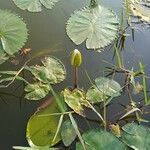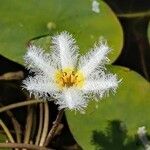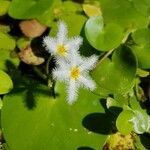Plants perennial, often spotted red-violet.. Stolons numerous.. Leaves circular, up to 30 cm. across, reddish beneath; petiole 1.5-6 cm. or even more.. Inflorescence usually 20-30-flowered; pedicels 4-10 cm. long.. Calyx 5-10 mm. long.. Corolla ± 2.5-3 cm. across, white with a yellow centre; tube ± 7-9 mm. long; corolla lobes covered entirely with hairs inside; heterostylous.. Stamens inserted 2/ 3 or 3/ 4 of the way up the corolla-tube; anthers in short-styled flowers ± 2.5-3 mm. long, filaments long-exserted, 2-3 mm. long; anthers in long-styled flowers similar but only up to 2 mm. long, filaments not exserted, 1-2 mm. long.. Gynoecium 5-8 or 10-14 mm.; ovary ovoid in both types of flowers, 3-4 mm. long.. Capsule ovoid, up to 6 mm. diameter, shorter than the calyx.. Seeds numerous, sometimes more than 50, smooth to ± tuberculate.
Rhizomes horizontal. Stems cylindric, unbranched. Petiole cylindric, 1-2 cm; leaf blade broadly ovate to subcordate, 3-18 cm, subcoriaceous, abaxially densely glandular, base cordate, margin entire; veins indistinct, palmate. Flowers many, clustered at nodes, 5merous, distylous. Pedicel cylindric, 3-5 cm. Calyx 3-6 mm, lobed to near base; lobes lanceolate to narrowly elliptic, apex obtuse. Corolla white with a yellow center, 7-12 mm; lobes ovate-elliptic, outside densely fimbriate-pilose, apex obtuse. Filaments flattened, linear, 1.5-1.7 mm; anthers sagittate, 2-2.2 mm. Style cylindric; stigma lobes triangular. Capsules elliptic, 3-5 mm, few seeded. Seeds brown, globose, 1.2-1.5 mm; seed coat smooth. Fl. and fr. Aug-Oct. 2n = 18 [or 36].
A herb which grows in water. It keeps growing from year to year. The roots are attached to the mud. The rhizomes are horizontal. The stem is like a cylinder and unbranched. It grows 1-2 m tall. The leaf stalk is like a cylinder. The leaf blade is 3-18 cm across. The leaf floats on the water. The leaf is round but with a heart shaped base. There are many flowers which are clustered at the nodes. The flowers are 1-2.5 cm across. They are white but can have a yellow base. The seeds are brown, round and 1-1.5 mm across. The seed coat is smooth. The capsules are oval and with few seeds. The capsules are 3-5 mm across.
Rhizomatous, aquatic perennial. Leaves floating, orbicular-cordate. Flowers 2 to several in fascicles at nodes, heterostylous, petals fringed, white or yellow.




